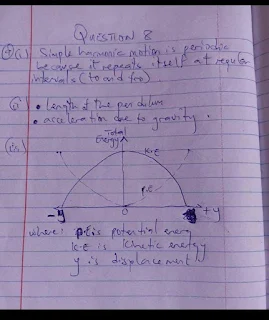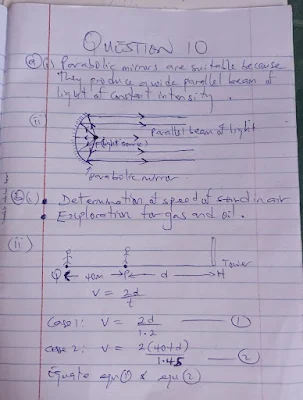Free 2024 WAEC May/June Physics (PHY) Essay (Theory) and Objectives (OBJ) Questions and Answers for School Candidates | Free 2024 WAEC May/June Physics Questions and Answers EXPO Room (May 23, 2024).
WAEC May/June 2024 [School Candidates] FREE PHYSICS QUESTION AND ANSWER ROOM.
PHYSICS WAEC
WAEC has provided resources to aid students in grasping the standards required for the Physics final examination.
These materials encompass general comments, performance analysis, noted strengths and weaknesses, and anticipated answers to questions.
They serve as valuable guidance for students preparing for the exam, offering insights into effective question approaches and meeting expected standards.
It's advisable for students to carefully review these resources to enhance their understanding and performance in the exam.
Daily Subscription - Per Subject
For quick access to answers, you can make direct mobile payments for each subject and practicals.
- Direct Mobile Payment Per Subject: N800 [Receive Answers On Time]
- Direct Mobile Payment Per Practical: N600 [Receive Answers On Time]
How to Subscribe for 2024 WAEC Physics OBJ and Theory Answers via Link
Follow these easy steps:
- Purchase MTN cards worth N800 (400 + 400 = 800).
- Open your messaging app, type the card pins correctly, and send them to 0704 280 9849.
- Do not call; just text. If the card pins are valid, you'll receive a confirmation reply, indicating your successful subscription.
- Relax and wait for your answers 30 minutes before the exam starts or after it begins.
Important Note:
- Do not send used card pins, as your number may be blacklisted
JOIN OUR VIP GROUP TO GET ANSWERS
General Comments on Physics Paper 2, May/June 2014:
The paper was comparable in scope and standard to previous years. Questions were clearly framed in simple language, accessible to candidates. Rubrics were clear, and marking schemes were detailed and easy to follow. The exam emphasized the psychomotor aspect more prominently, while cognitive and affective domains met acceptable standards.
Candidates performed better compared to previous years, with a candidate population of 665,669 achieving a raw mean score of 16 and a standard deviation of 8.77. This contrasts with a raw mean score of 13 and a standard deviation of 8.77 in the May/June 2013 WASSCE, which had a candidate population of 636,924.
Physics Question 1:
A particle is projected horizontally at 10 m/s from the top of a tower 20 m high. Calculate the horizontal distance traveled by the particle when it hits the level ground.
[g = 10 m/s^2]
Observation:
This question was attempted well by most candidates, as it is a familiar topic. However, some candidates mistakenly used "2g" instead of simply "g". Nevertheless, the majority of candidates correctly applied the formula, although a few struggled with completing the arithmetic calculations.
Question 2
A particle is projected horizontally at 15 m/s from a height of 20 m. Calculate the horizontal distance covered by the particle just before hitting the ground.
[g = 10 m/s2]
Observation:
Many candidates provided acceptable responses, resulting in high performance. However, a few failed to apply the appropriate formula.
Expected Answer:
Let R represent the horizontal distance covered at time, t.
We know:
h = (1/2)gt2
Given:
20 = (1/2) × 10 × t2
Solving for t:
t = 2 seconds
Then, we use the formula:
R = ut
R = 15 × 2
R = 30 meters.
Physics Question 3
Explain why mercury does not wet glass while water does.
Observation:
Good responses were given by many candidates. Few fumbled due to their failure to relate cohesion and adhesion forces with molecules of mercury and glass.
Expected Answers:
Mercury does not wet glass because (force of) cohesion/attraction of mercury molecules is greater than (force of) adhesion/attraction between glass and mercury molecules.
Water wets glass because (force of) adhesion/attraction between glass and water molecules is greater than (force of) cohesion/attraction of water molecules.
Physics paper 2 Question 4
Explain what is meant by cations.
Draw and label an electrolytic cell.
Observation:
(a) Many candidates gave an incomplete explanation. Many stopped at "cations are positive ions" and not all positive ions are cations.
(b) Many candidates were unable to present a diagram that shows a cathode and an anode dipped in an electrolyte or they drew wrong diagrams connecting external components to an otherwise correct set-up.
Very poor performance was registered by candidates.
Expected Answers:
(a) Cations – are positive ions that are attracted to the cathode (during electrolysis).
(b) Diagram
Correct diagram/sketch: labeling cathode, anode, and electrolyte.
Question 5 – physics Paper 2
State three methods of polarizing an unpolarized light.
Observation:
This question on polarization was very popular among the candidates and their responses were quite commendable.
Physics Question 6
State Faraday’s second law of electrolysis.
An electric charge of 9.6 x 10^4 C liberates 1 mole of substance containing 6.0 x 10^23 atoms. Determine the value of the electronic charge.
Observation:
In part (a), many candidates were able to state the law correctly. Candidates’ performance in part (b) was poor due to lack of knowledge of the appropriate formula.
Expected Answers:
(a) If the same quantity of electricity is passed through different voltameters/electrolytes connected in series the masses of the substances liberated/deposited during electrolysis is (directly) proportional to their chemical equivalents.
OR The mass of an element deposited/liberated during electrolysis is (directly) proportional to the chemical equivalent of the element.
(b) Let e represent the electronic charge.
e = Faraday’s constant / Avogadro’s number
e = 9.6 x 10^4 / 6.0 x 10^23
e = 1.60 x 10^-19 C
WAEC PHYSICS OBJECTIVES (OBJ) COMPLETION 2024
WAEC PHYSICS ESSAY OR THEORY ANSWERS FOR 2024:
2b.
The energy stored in a stretched wire, E, can be calculated using the formula:
E = (1/2) × Y × A × e2
Where:
- E represents the energy stored in the wire.
- Y is the material's stiffness, measured by its Young's modulus.
- A denotes the wire's cross-sectional area.
- e is the extension or change in length of the wire from its initial length.
You can see that Young's modulus and cross-sectional area directly influence the energy stored in the wire, which is proportional to the square of the extension.
(5a) (SELECT ANY ONE)
Diffusion is the process by which particles or fluid molecules migrate from a region of higher concentration to a region of lower concentration. This movement is brought about by the random
2024 WAEC PHYSICS QUESTIONS PAPER
2023 WAEC PHYSICS OBJECTIVES (OBJ) ANSWERS
2022 WAEC Physics Obj Answers:
2023 PHYSICS OBJ REAL ANSWERS
2023 WAEC PHYSICS ESSAY AND THEORY ANSWERS:
2023 PHYSICS ESSAY REAL ANSWERS
Tips To Pass Waec Physics Exam.
- Know the syllabus: Familiarize yourself with the WAEC Physics syllabus to understand the topics and subtopics that will be covered in the exam. This will help you organize your study plan accordingly.
- Understand the concepts: Physics is a subject that requires a solid understanding of fundamental concepts. Take the time to read your textbook, make notes, and clarify any doubts you may have. Seek additional resources like online tutorials or videos if needed.
- Practice past papers: Obtain past WAEC Physics exam papers and practice solving them within the allotted time. This will help you become familiar with the exam format, identify the types of questions asked, and improve your time management skills.
- Work on problem-solving skills: Physics exams often involve problem-solving questions. Practice solving various types of problems, paying attention to the principles and formulas used. Understand the steps involved in reaching a solution and try to apply them to different scenarios.
- Create a study schedule: Plan your study sessions effectively by creating a schedule. Allocate specific time slots for each topic, ensuring that you cover all the essential areas. Break down complex topics into smaller, manageable portions for better understanding.
- Use visual aids and diagrams: Physics concepts can sometimes be abstract. Utilize visual aids such as diagrams, charts, and graphs to enhance your understanding and memory retention. Create your own visuals or refer to textbooks and online resources.
- Join study groups or seek help: Collaborate with classmates or form study groups to discuss and clarify doubts. Explaining concepts to others helps reinforce your understanding. If you're struggling with certain topics, don't hesitate to seek help from your teacher, classmates, or online forums.
- Review regularly: Regular revision is crucial to retain information. Set aside time each week to review previously covered topics, reinforce concepts, and practice problem-solving. This will help you build a strong foundation and reduce the chances of forgetting key information.
- Take care of yourself: Maintaining a healthy lifestyle during your exam preparation is essential. Get enough sleep, eat nutritious meals, and engage in physical activity to stay energized and focused. Avoid excessive stress and practice relaxation techniques if needed.
- Stay confident and positive: Believe in your abilities and approach the exam with a positive mindset. Manage exam anxiety by taking deep breaths, visualizing success, and reminding yourself of your preparation efforts.












